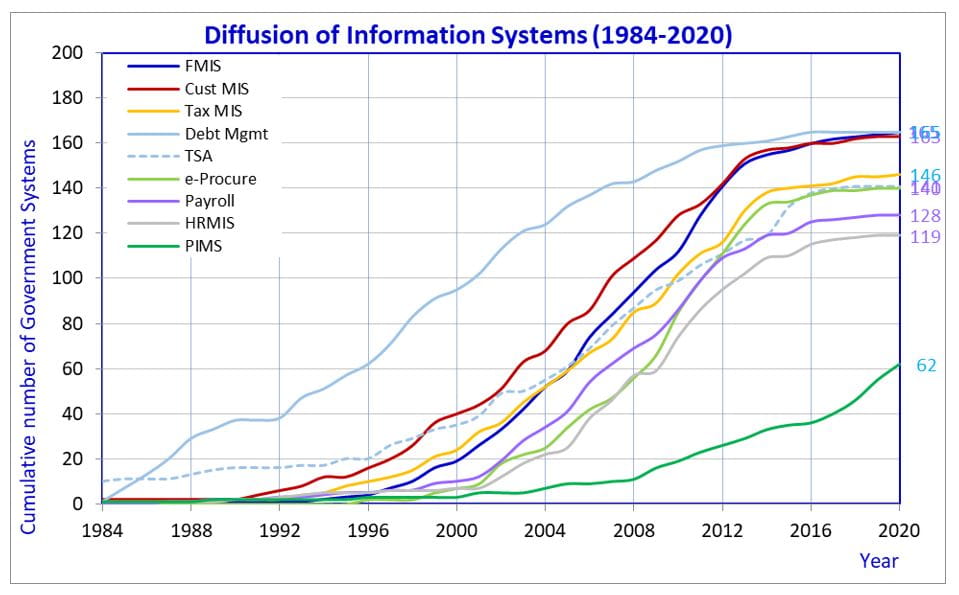In the past decade, the data revolution has transformed productivity in the private sector. The public sector is being transformed by digital systems as well, but in a different way. As the figure below shows, the diffusion of digital systems in government has been substantial, with many countries now undertaking fiscal operations such as financial management, customs, tax administration, and debt management through digital systems.
Source: GovTech Maturity Index; as reported in Herrera Gutierrez, Ramalho and Kim (2023)
Note: The acronyms used for management information systems (MIS) are as follows: financial management information system (FMIS), customs MIS (Cust MIS), treasury single account (TSA), e-procurement (e-Procure), human resource MIS (HRMIS), and public investment management system (PIMS).
While budgeting, procurement, and taxation have increasingly gone online, the data that digital records produce are often used solely for record keeping and the creation of audit trails, rather than for managing organizations better and increasing public sector productivity. Even though financial outlays increasingly flow digitally in the public sector, the resulting public dataverse is not being exploited to strengthen expenditure effectiveness and improve service delivery.
Just like in the private sector, the digitalization of the world’s governments could improve expenditure effectiveness. Data can paint a richer picture of the functioning of government than ever before. They can point to bottlenecks and outliers, best practices, and opportunities—for instance, for more cost-effective procurement of goods or better calibration of public pay to motivate and retain employees.
But unlocking these insights requires a concerted effort to capitalize on administrative and survey data and repurpose them for analytics.
The Government Analytics Handbook, recently published by the World Bank, lays out how to leverage the many sources of data available to public sector managers to make governments work better. By using the Handbook, public sector managers—and any public officials interested in public administration reform—can learn from the examples of their counterparts all over the world who have begun to harness the power of government analytics. The Handbook showcases how the data from governments’ digital systems can be repurposed for analytics, generating better evidence to improve the delivery of public services.
The Handbookis a blueprint for raising expenditure effectiveness across the public sector. It is conveniently structured to help readers quickly identify data sources they already have access to so they can address specific expenditure effectiveness challenges. The book offers advice, tools and practical examples to repurpose these data for analytics:
- Part 1 of the Handbook offers a broad overview of government analytics. Read this if you are busy, or if you want an introduction and summary.
- Part 2 lays a foundation for government analytics by outlining cross-cutting themes, such as statistical tools and skills, holistic measurement approaches, and ethical principles that make government analytics effective.
- Part 3 dives into the many sources of administrative data available in government databases. It includes chapters on data sources such as - human resources and payroll, procurement, case productivity data, and expenditure data, as well as the different questions these data help answer about the wage bill, corruption, customs efficiency, cost-effective procurement, spending, and everything in between.
- Part 4 explains how to use data from public service surveys to better understand how public sector organizations work and to measure the quality of management. It also offers an overview of the latest research into how to design and implement these surveys as effectively as possible.
- Part 5 turns to external assessments—including household and citizen surveys, measures of service delivery, and anthropological studies—to show how these data sources offer a richer overall picture of government processes and outcomes.
The Government Analytics Handbook also comes with toolkits (available on worldbank.org/governmentanalytics) that enable readers to implement the analytics discussed. With these toolkits and the advice in the Handbook, public officials and managers can start improving productivity right now, at low cost, by making use of the data they already have.
It is time for the data revolution to come to public administration. The public sector must not only account for the work it does but use its data to work better and spend more effectively.







